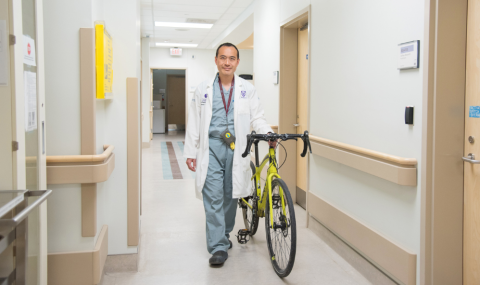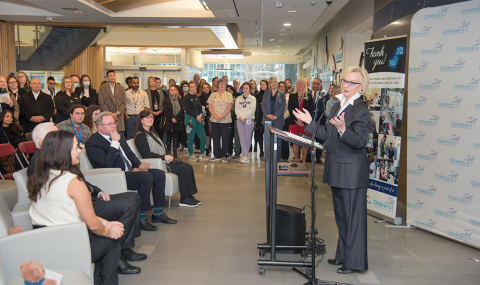Program Description:
The Operating Room nurse draws from a unique body of basic and advanced nursing knowledge of anatomy, physiology, psychosocial concepts, and pharmacology to provide care to the surgical patient. The Operating Room nurse collaborates with the health care team to provide care to patients in an environment in which basic lifesustaining
needs are the highest priority. This care is currently provided on two sites: the Victoria Hospital) and University Hospital. The operating rooms at LHSC provide a dynamic fast-paced environment and
performed more than 23,400 surgery cases Victoria Hospital
The Victoria Hospital Operating Room provides patient care to the following services: Vascular, Orthopaedic Trauma, Thoracic (including Thoracic Oncology), General Surgery, Dental, Ophthalmology (Paediatrics), ENT (One-day-care patients to Head & Neck Reconstruction), Plastics, Neurosurgery (Paediatrics/Trauma), Urology, and GYN.
University Hospital
University Campus Operating Room provides patient care to the following services:
- Orthopaedics (Total Joints)/Sports Medicine
- General Surgery
- Urology
- Plastics
- Liver (Living Related as well as Cadaveric)
- Transplants, Kidney (Living Related, Laparoscopic Living Related and Cadaveric)
- Transplants, Cardiac (Coronary Artery
Bypass Grafts, Valve Replacement, and Robotic procedures), ENT, Dental, and Neurosurgery (including Aneurysms).
The unit is active in education and research, in all discipline levels, in all programs, with emphasis in Anaesthesia, Cardiac, Multi-organ Transplantation, Neurosurgery, Orthopaedics, Sports Medicine, and Robotic Assisted Surgery.
General Information:
Victoria Hospital
- 15 ORs
- 1400 patients/month (both adult and paediatric)
- Team Composition: RN, RPN/ORT, RRTs, Physicians, Clinical Educator
- Hospital Site: Level 2 Victoria Hospital
University Hospital
- 16 ORs with one OR specifically designed for Radiology/Robotic surgery
- 670 adult patients/month Staffing
Two completely separate roles have been identified for nurses providing care for the patient during their operative experience: circulating and scrubbing.
There will be at least one Registered Nurse assigned to each operating room.
The Circulating Role includes:
- The registered nurse is the primary circulator during all surgical procedures.
- The circulating nurse coordinates the activities of the individual theatre, assigns activities to other team members, utilizes the nursing process, serves as the patient’s advocate, ensures a safe environment for the patient and documents care provided during the operative phase of patient care.
The Scrub Role includes:
- The scrub role may be a Registered Nurse or a Registered Practical Nurse/Operating Room Technician
- The scrub nurse works directly with the surgeon within the sterile field anticipating and passing instruments, sponges, and other items needed during the surgical procedure.
Background Essentials:
Registered Nurse
- Recent OR experience
- Community college post graduate certification required
- Excellent interpersonal, organizational and communication skills
- Initiative and ability to work both independently and as an effective team member
- Proven ability to function productively in a very demanding environment with a large patient turnover
Operating Room Technician
- Community College ORT Certificate required
- Registered Practical Nurse with current certificate of registration
- Recent OR Scrub technician role required
- Organizational, interpersonal and communication skills
- Proven ability to work as an effective member of an interdisciplinary team
- Available for all tours of duty
Professional Assets:
- CNA Certification in Operating Room Nursing
- BCLS
- Participation in Professional Organizations, such as: Registered Nurses Association of Ontario, Operating Room Nurses Association of Canada, and London & District Operating Room Nurses Association
Professional Development:
The orientation to the Operating Room is individually structured; competency based with the length determined by the new staff member’s identified learning needs (generally 3- 6 months). The orientation consists of lectures, self-directed learning packets and a
clinical practicum in various service rotations. A preceptor, using a competency checklist and service specific orientation tool orients staff. The new staff member will receive constructive feedback daily as well as at planned intervals throughout the orientation program.
The clinical/patient assignment for a new staff member who has completed the orientation program will be based on the following principles:
- Self-evaluation by the new staff member
- The daily assignment will be based upon an assessment of the new staff member’s knowledge, skill, and expertise as well as patient needs. The new staff member’s competency must match the care needs of the patient.
- Regular updates and in-services
- Support to attend conferences, courses when possible
- Ongoing support for continuing education i.e. post-RN BScN, CNA certification
Student Consolidation:
- BScN – Year 1: observation
- Year 2: observation
- Year 3: observation
- Year 4: Consolidation experience within perioperative program
- Post RN: Yes
- Refresher: Willing to Consider
- New Graduate: Willing to Consider
- RPN: Post Graduate


